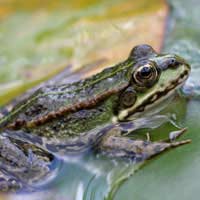How to Make A Garden Wildlife Pond

If you’re keen to encourage more wildlife into your garden, then making your own wildlife pond is a surefire way to do so. A wildlife pond performs a number of tasks – firstly, a well-managed wildlife pond will become a thriving habitat for all kinds of creatures. Amphibians, aquatic animals and insects alike will find food and shelter within the microcosm of the pond.
Secondly, a wildlife pond can become a haven for wild birds and mammals. At times it may prove a lifesaver, as it may be the only source of water in times of drought and during high summer.
Thirdly, a wildlife pond will prove a popular breeding ground for many different amphibians and insects. You’ll be surprised at how quickly your wild residents will take the opportunity to move in and make the most of your pond!
So if you’re keen to get started, this article will guide you through the rudimentary tasks and decisions you’ll need to make when creating your wildlife pond.
Considerations
Obviously, before you start you’ll need to make a few considerations. One of the biggest and most crucial decisions you’ll need to make is where to site your wildlife pond. It is such an important consideration because the site will, by and large, determine how successful the pond is.So when choosing the location of your pond, try to opt for a spot or a corner of your garden that’s quiet and will remain undisturbed. This allows the resident and visiting wildlife to feel safe and secure. Also try to site the pond away from any deciduous trees, as their shedding leaves in autumn can prove to be a menace.
Your wildlife pond will need a bare minimum of 4 hours of sunlight a day. Having the pond in a spot that is constantly sunny can lead to an overabundance of oxygen-gobbling algae. Similarly, a pond that is mostly in shade will be cold and uninviting, and is less likely to thrive.
Another consideration is whether you want the pond to have moving water from a water feature. If this is the case, then you may need to install an electric pump that needs to be hooked up to your main power supply. But bear in mind that there are a number of solar-powered water pumps currently available. It’s also worth noting that frogs in particular much prefer still, undisturbed water.
The final consideration you need to make regards young children – if you have young children that are likely to play near the pond, make sure that you take the necessary step to secure the site with fence. Only allow your children near the pond when supervised.
Digging Your Pond
The shape and depth of your pond is also important. A pond will sheer sides will prove a death trap for many animals, particularly small animals such as hedgehogs that can swim, but have no way of crawling out of the water once they’re in it. This is why it’s so important to have a pond with a number of shallow shelves. These shelves not only protect the wildlife from drowning, but also allow small mammals and birds safe access to drink, wade and bathe in the water. A shelf around an inch deep is ideal, followed by one or two deeper shelves around 12 inches deep.Your wildlife pond should be at least 18-24 inches at the deepest point. However, the deeper you can make the pond, the better as this aids hibernation and shelter for many pond-dwellers.
Once you’ve dug out your wildlife pond, you’ll need to line it with around an inch of sand or carpet to help avoid punctures in the pond liner. Remove any turf from the surrounding area of the pond. You can then line the pond, making sure to have enough excess at the sides to assist the growth of marginal plants. Secure the pond liner in place with heavy stones or logs, and before filling with water, line the bottom with a few rocks or broken crocks. These will act as shelters and hidey-holes for your pond residents.
As you begin filling your pond with water, you may find that you need to readjust the stones and logs as the pond liner stretches into place.
Once your pond is filled with water, allow a few days for the water to settle before planting. You can line the edges with stones to create a beached area, as well as putting down logs and upturned broken pots or terracotta drainpipes as sheltered habitats.
Planting Your Pond
One very important point is that you should never put fish into your wildlife pond, as they will eat much of the wildlife that comes to shelter and live there!Your wildlife pond will basically need three types of plants – marginals (for planting around the boggy edges), oxygenating plants (to help the pond regulate itself and keep clean) and aquatic plants (to provide food, shade and shelter for pond life).
When choosing your plants, think carefully about what’s suited to your climate. It is also really important that if you’re planting marginals and aquatic plants, you should only use special aquatic soil. Always try to opt for native species of pond plants, as these are most likely to provide native wildlife with everything they need.
Taller marginals will provide shelter and breeding grounds for certain types of insects, whereas frogs and other amphibians may prefer low-growing foliage on your pond shelves. Always take your time to research and choose your aquatic plants, as your choices will ultimately dictate how successful your pond becomes. Get the balance right and your wildlife pond will require very little management and interference.








